

The Telescope Makers
of Springfield, Vermont
One Way of Absorbing Astronomy
by Russell W. Porter, 1923, Polar Explorer, Artist, Astronomer, and Founder of the Springfield Telescope Makers
In a hill town of the Green Mountain State there exists a thriving community whose industry is the manufacture of certain machine tools well known throughout the world. By virtue of this industry there are a great many machinists trained to accurate and careful workmanship, interested in any instrument of precision containing complicated mechanical motion.
When, three years ago, the writer returned to his home town to take up his residence after an absence of many years to astronomical work in the north polar regions, he found a fertile field awaiting him, where the only incentive needed for the study of the heavens, and becoming better acquainted with this universe of ours, was the possession by these men of powerful telescopes. For it is true that astronomy, from a popular standpoint, is handicapped by the inability of the average workman to own an expensive astronomical telescope. It is also true that if an amateur starts out to build a telescope just for fun, he will find before his labors are over that he has become seriously interested in the wonderful mechanism of our universe. And finally there is understandably the stimulus of being able to unlock the mysteries of the heavens by a tool fashioned by one's own hand.
Among this group of machinists there were several who had their own small machine shops, usually in the cellars of their homes, where they could work on their mountings. But the success of the Springfield Telescope Makers lies to a great extent in having as the President of one of the large industrial plants an amateur astronomer in entire sympathy with the movement, James Hartness, who has already made his contribution to astronomy through the invention of the turret telescope, whereby an observer may now work at the eyepiece in perfect comfort regardless of the outside temperature conditions.
An unused basement in one of the shops was given over for our use and here gathered fifteen embryo astronomers under the writer's guidance. The Newtonian reflector, of course, was the logical type selected, not only for its simple efficiency, but on account of its cheapness. The principles of the instrument were shown on a blackboard and the writer remembers experiencing quite a thrill in observing the response from the men when he told them that while they were accustomed in the shops to working to the limits of one thousandth of an inch, they would now, in making their mirrors, have to set the limits a thousand times smaller, viz., to one millionth, by the remarkable but exceedingly simple device known as the knife edge test.
 |
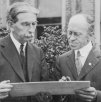 |
 |
 |
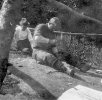 |
Each one was allowed all possible latitude in exercising his mechanical ingenuity as we passed through the different operations. Some made their stands from barrels filled with sand or iron casting; some set up their laps on benches, and some made wooden pedestal stands. One of the men was an expert pattern maker, so when any device in wood was required, we always sure of obtaining it just right.
The testing bench consisted of a long, smooth and straight plank fastened to a shop bench. At one end a large three-jawed lathe chuck held the mirror, while the knife and artificial star (acetylene) could slide along the plank to any desired radius of curvature. This plank I still possess as a great treasure. Over its surface are, to a layman, indecipherable symbols and hieroglyphics, where the writer explained to each student, as he tested his mirror, the interpretation of the knife edge shadows.
Nearly every man got the "idea" and realize why he was to alter the stroke of his mirror on the lap to change the curve of its surface, in working towards the spherical or paraboloidal figures.
There was one person, however, who was totally unable to see any of the knife shadows. This person strange to say was a woman, our only female member, a stenographer from one of the offices. She could see nothing except what she described as a dark diagonal shadow line passing diametrically across the mirror. I have never been able to understand or explain this freak of vision. However, the young lady got along all right in working by faith alone, and produced a fair mirror, and I believe the only one with a perfectly polished surface. By this I mean free from pits and scratches. I had prided myself in having in the class the only woman telescope maker since Caroline Herschel. She was much elated over the fact, but considerably downcast when on returning from a trip to the Brashear's at Pittsburgh, I had to confess that I had met there a woman who, Mr. McDowell informed me, had produced many mirrors for telescopes during the war.
 |
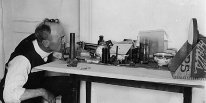 |
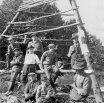 |
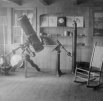 |
 |
It was interesting to observe the effect of temperament of the different men on the character of their work. Some, wishing to drive straight to the finish in the quickest time, would get into deep water at once by using too much pressure, too fast strokes, overheating their glass, over parabolizing and having to go back to fine grinding again. Others, usually the older men, worked slowly, carefully, following instructions exactly, religiously protecting their mirror and abrasives, and arriving finally with glass surfaces of excellent figure.
This part of the work covered two or three evenings a week for the early winter months, and all but one finished his mirror. They were all then given a blueprint of a standard equatorial mounting of the German counterbalanced type, but the principle of the equatorial mounting was only explained. It was shown that there were many different ways of making a telescope follow the stars and maintain an equatorial axis, - the English Fork, the double yoke, the bent or Coude' form, and the enclosed turret. Each mechanic thereafter went his own way capable of taking care of himself. The resources of the shops were made available and certain machines could be used at certain hours.
The pattern maker was advised to make his mounting of wood and he did so, the only metal being the right ascension worm and wheel and the brass bands around the tube.
The mirrors ran from five to ten inches in aperture and the focal lengths about eight times the diameters. Totally reflecting prisms and eyepieces of the very finest make available were purchased; so that the expense of the optical parts averaged about twenty dollars for each member. About two-thirds of the mountings are finished. As each man knew that the eyes of his fellow members were upon him, he produced the best that was in him, the result being mountings that compare favorably with those of professionals, both as to accuracy of the working parts and quality of finish.
At the town fair the next fall the telescopes made an unique exhibit. Here were displayed the glass in different stages of grinding, an automatic machine was polishing a mirror, and out doors the townspeople were looking through the instruments, watching the horse racing, following the movements of the aeroplanes or viewing distant terrestrial objects. The pattern maker overheard two farmers examining his wooden mounting. "Looks like a churn to me" one of them said. "No", replied the other, "it's one of those new kind of washing machines." It is not improbable that this beginning is the forerunner of a new industry for Springfield.
However, the important outstanding fact is this; interest did not stop with the completion of the telescopes. As we needed a more reliable value of the latitude and longitude of Springfield that was available from existing maps, the telescope makers found an old station on Hawks Mountain, just outside the township, occupied years ago in the government triangulation of New England. They camped on the mountain, built a substantial tower and signal over the station, dedicated a bronze tablet marking the spot, and assisted in carrying the triangulation with a theodolite to the village. This gives us the spherical coordinates of Springfield far more accurately that could be obtained by any of our instruments by observation.
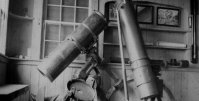 |
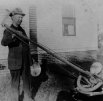 |
 |
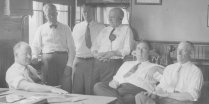 |
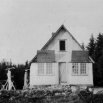 |
On another occasion they spent the night on the summit of Mt. Ephraim, the highest point in the township. This gathering I believe, in the unique in the annals of astronomy. There on a bald rocky pasture were some fifteen men and two reflecting telescopes in good equatorial adjustment. Throughout that summer night, from the appearance of the first star until dawn, these men were exploring the heavens. It proven to be good seeing notwithstanding a stiff wind. The light from a roaring campfire revealed a circle of animated faces listening intently to some celestial fact just brought out at the eyepiece of one of the instruments. It might have been the mechanics of a binary system, or some physical aspect of a planet. For some reason the high school principal has asked permission to join us. It must have been a revelation to him on discovering the mainspring that brought these working-men to the summit of a mountain where they spent the entire night arguing around a campfire.
I slept scarcely a wink. On dozing off one would hear, "What's that fuzzy looking thing? See it? At the edge of the field of view?" or "I've got it. I've got it." "Got what?" "Epsilon Lyra." "See 'em, each one double."
Our trips to various points have a large radius, as half of the members own cars. One of these, to the home of the pattern maker, on a beautiful farm in the Connecticut valley, is memorable, - more from the social side (the astronomers' wives were present) than the scientific. For on setting up the "Washing Machine" it was found that the atmosphere was in turmoil, it being a very warm day. The high points, as I remember them, were freedom of the strawberry patch, the thick cream, the honey, and - most wonderful of all, the baked beans that had cooked all night in a hole in the ground.
The winter gatherings are at the members' homes. One evening it may be a discussion of driving clocks and mountings. Two evenings were devoted to illustrated talks on general Astronomy prepared by the Yerkes Observatory. On one occasion a member exhibited a spectrometer of his own making and showed us how the refractive and dispersive characteristics of good optical glass are measured. The interference of light took up another evening with its application to testing flat surfaces. The men were all familiar with the way flat metal surface plates are used in the shops, as well as the gauge blocks used as length standards. It was an eye opener when they found that light could be used to carry these measurements a thousand times farther than any mechanical devices with which they were familiar.
At our next meeting the method of measuring star diameter by light interference will be taken up and the actual fringes will be produced and a real demonstration provided.
This, then, is one way of teaching astronomy. I am convinced that these workmen, some of whom have only attended district schools, have a far better conception of the great mechanism of the solar system than graduates of our high school. They have, perhaps unconsciously, absorbed the fundamental facts of our solar system. They sense the direction of the axis of our earth and know where its north end at least pierces the celestial sphere. They had to in order to adjust their telescopes. They sense the celestial equator sweeping across the southern skies, and see upon it the dial of an immense clock whose hours come to the meridian in unfailing regularity. They know too where zero right ascension is to be found.
Surely the making and putting into use of a powerful astronomical telescope goes far toward properly orienting one's self in the great scheme of things.
RWP, Springfield, Vermont, March, 1923
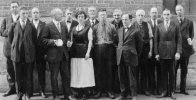 |
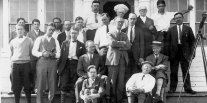 |
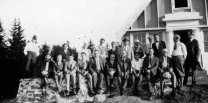 |
Back to the Early History Page